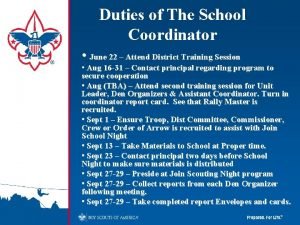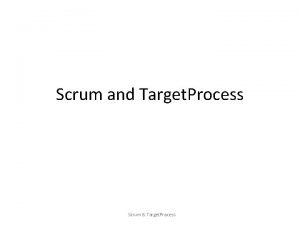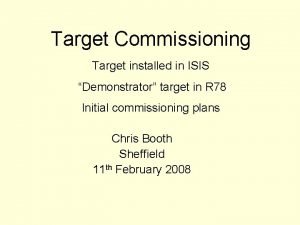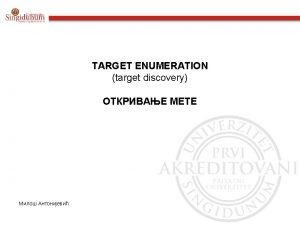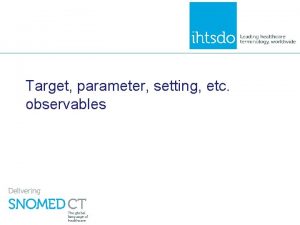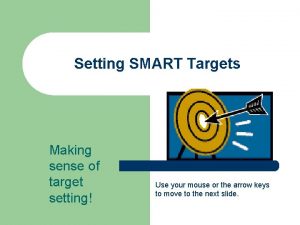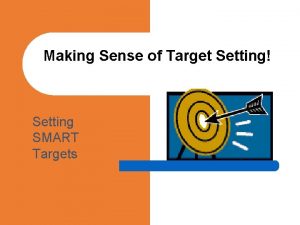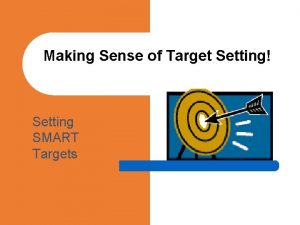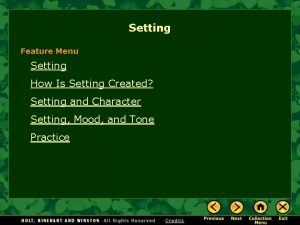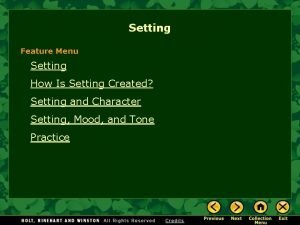TARGET SETTING SESSION GEOGRAPHY QUICK WINS 80 TO














- Slides: 14

` TARGET SETTING SESSION GEOGRAPHY (QUICK WINS) 80% TO A DISTINCTION 30% TO PASS 1

Preamble • This last push strategy has been informed by findings from the 2018 analytical, moderation and diagnostic reports, as well as analysis of final NSC results and term performance of the subject. These strategies are aimed at ensuring that our high risk learners pass the subject and also ensuring increased learner attainment and number of distinctions in the subject.

Responsibility and timeframes • Subject advisors to ensure that schools have all the necessary resources; mediate Quick wins with teachers; • Teachers to implement this strategies intensively before prelim exams; help learners focus on their strengths

DIFFERENTIATION DURING REVISION • (Divide learners in the following 3 groups in class, if you one teacher. If there is more than 1 Geo teacher, each can focus on a group) • Learners at risk (L 1 and L 2): Drill concepts, focus on areas as outlined in quick wins to score marks • Moderate achievers (Level 3 – 5): let learners sit in groups. Give them past paper questions to discuss in the group and come up with answers. (teacher still need to be present • High flyers/Achievers (Level 6 -7): Give as much as possible past papers for learners to work through. They need to take it a step further and work on that. NB!! In all the groups you need to assist and discuss answers and give feedback. Ask geographical questions and stick to geographical language.

LEVEL 4/5 -7 • HOW TO MOVE FROM LEVEL 4/5 TO LEVEL 7

GEOGRAPHY – important tips to move from Level 5 and 6 to Level 7 • • Paper 1(Theory) Work through as much past papers as possible; 2014 to 2018 Final, Supplementary and June SC (2019) question papers; and see the different ways in which the same content can be tested; Use the past question papers and find the answer on your own and compare your answer to memo later on and DO NOT take the memo and go study the memo, it will not help at all There are 3 hours to answer three questions in Paper 1, one hour per question, utilize this time optimally (the best way possible) Look at the mark allocation per item (question) e. g. 3 x 2(6) or 2 x 2(4) to guide you on how many facts you need to write to get the marks; Understand the meaning of the Action word/Verb, e. g. Suggest, Account etc. Let the action word/verb guide you – Name will require one word, Explain requires sentences Circle action verbs and underline key phrases/words; “dissect” (break up in smaller pieces) the longer questions – break it up into smaller pieces to give a better understanding WHAT answer the question expects.

GEOGRAPHY – important tips to move from Level 5 and 6 to Level 7 • • Paper 1(Theory) Work through as much past papers as possible; 2014 to 2018 Final, Supplementary and June SC (2019) question papers; and see the different ways in which the same content can be tested; Use the past question papers and find the answer on your own and compare your answer to memo later on and DO NOT take the memo and go study the memo, it will not help at all There are 3 hours to answer three questions in Paper 1, one hour per question, utilize this time optimally (the best way possible) Look at the mark allocation per item (question) e. g. 3 x 2(6) or 2 x 2(4) to guide you on how many facts you need to write to get the marks; Understand the meaning of the Action word/Verb, e. g. Suggest, Account etc. Let the action word/verb guide you – Name will require one word, Explain requires sentences Circle action verbs and underline key phrases/words; “dissect” (break up in smaller pieces) the longer questions – break it up into smaller pieces to give a better understanding WHAT answer the question expects.

Question and Paragraph questioning skills NB!! (still very relevant) Example of how to Interpret and break up questions into digestible pieces to lead learner to correct answer and score marks:

How to pass Geography at least @ 30% • How to guide your learner to get at least 30%

GEOGRAPHY- how to get at least 30% to pass QUICK WINS (Progressed / High Risk Learners) • Theory paper (P 1) • Know concepts well, first part of all four 75 mark questions (of which 3 should be answered); which is the 7+8=15 marks, are based on concepts/definitions; concepts; thus need to be drilled. 15 x 3 =45 marks can be scored by knowing concepts; • These mentioned above are the 1. 1 and 1. 2; 2. 1 and 2. 2; 3. 1 and 3. 2; 4. 1 and 4. 2 short questions; • Understand the skill of elimination when answering multiple choice questions • Marks can be scored if learners know their concepts well • Attempt the paragraph questions do not leave it out ; even if they get 2/8 marks, its 2 marks towards a pass mark. • Underline verb and key words to know what the question requires; • Know your diagrams and be able to draw simple diagrams it (3) • Write in full sentences unless a one word answer is required; • A GIVEN***: if the Industrial regions, SDI’s and IDZs is studied well, learners given maps on the areas and applied well, learners can score minimum 30/35 out of 45 • Candidates can score + 60 marks in Paper 1 by studying hard and just answer the basic recall of work in P 1.

GEOGRAPHY- 30% minimum TO PASS • Map work (P 2): • Know map work well and learner can score 10 out of 15 by answering the multiple choice questions; Know how to eliminate wrong answers first • 10 out of 20 with the calculations (area calculations; magnetic bearing and magnetic declination; vertical exaggeration; gradient) • At least 5 -10 out of 30 by attempting Question 3 (map work application and interpretation) – knowing their street patterns; land use zones; economic sectors; etc (studying theory – this is application) • GIS – just by knowing concepts candidates can score 6 out of 15 marks; • A candidate can get +- 30 to 33 out of 75 by putting every effort into this afternoon paper AND making use of the FULL 1 and one half of an hour.

How a learner can 30% (90/300) to pass Geography GEOGRAPHY- 30% minimum TO PASS Where learners can “score” marks Total mark of questions Min mark learner get Short objective questions (7+8=15) Questions 1. 1/2. 1/3. 1/4. 1 45 35 Recall questions – 1. 3. 1/1. 4. 1/2. 3. 1/2. 4. 1/3. 3. 1/3. 4. 1 15 Paragraph questions 8 marks x 2 paragraph questions (per 75 mark question) x 3 2 marks x 2 x 3 questions = 12 Industrial regions/SDI’s/IDZ’s + - 15 marks per question for these 3 =45 35 marks 97 Multiple choice questions 15 10/15 Calculations Min 10/15 Map work Interpretation and Application 10/20 GIS (if they can just know their concepts) 15 + - 6 marks 36 for map work/75 Total 97 + 36 = 133 Paper 1 Paper 2

More Tips Learners must know the concepts well! Drill! Learners must attempt all sections of the paper (Do not leave any blank Spaces) Always look at the mark allocation for the question to guide you. Learners must do Data handling type questions (mostly question 4) Let learners work through past papers to practise the data handling questions. (Class Room Practice required) ü Learners must practice the 8 mark paragraph type questions (Class Room Practice) ü Use the 10 minute reading time to identify the questions that will give the most marks (Candidate knows best) Start with that question that you know best, even if it is question 4. It builds the confidence of the learner, and he/she will do better in the other questions. ü Number questions correctly (you don’t want to lose marks by wrong numbering; ü Answer JUST THREE out of the FOUR questions (paper 1); ü GO WRITE THE MAPWORK PAPER (P 2) IN THE AFTERNOON AND ATTEMPT THE WHOLE PAPER, USE UP THE WHOLE ONE AND A HALF HOURS AND DON’T LEAVE BLANK SPACES. ü ü

 How to identify quick wins
How to identify quick wins Quick find algorithm
Quick find algorithm 1.7.6 - quick check: frost quick check
1.7.6 - quick check: frost quick check Primary target market and secondary target market
Primary target market and secondary target market Quick setting cement composition
Quick setting cement composition Target setting in schools
Target setting in schools How does katniss plan to strike at the careers
How does katniss plan to strike at the careers Eggs hearse sized hay lee
Eggs hearse sized hay lee He that wins soul is wise
He that wins soul is wise Windows internet name service (wins)
Windows internet name service (wins) School wins coordinator duties and responsibilities
School wins coordinator duties and responsibilities Wins soft innovations private limited
Wins soft innovations private limited Cbs small wins
Cbs small wins Border security using wireless integrated network sensors
Border security using wireless integrated network sensors The selfish giant part 2
The selfish giant part 2










